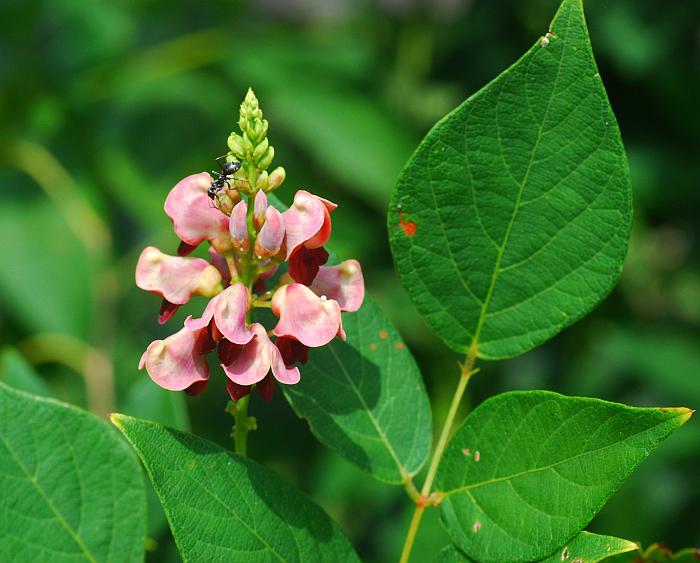Apios americana Medik.
Groundnut

Native
CC = 6
CW = -3
MOC = 58
© SRTurner
Apios americana Medik.Groundnut | |
 |
Native CC = 6 CW = -3 MOC = 58 |
© SRTurner |
|
Family - Fabaceae/Faboideae Habit - Perennial herb, climbing on other vegetation, with long rhizomes bearing fleshy tubers, these 2-5 cm long and often appearing in chains. Sap milky. Stems - Twining, to 3 m, thin, herbaceous, glabrous or appressed pubescent.
Leaves - Alternate, odd-pinnately compound usually with 5 or 7 leaflets, the petiole 1.5-7.0 cm long, glabrous or hairy. Stipules 4-7 mm long, hairlike, deciduous; stipels 1-2 mm long, inconspicuous, deciduous. Leaflets 2-10 cm long, 2-6 cm wide, lanceolate to ovate, rounded at the base, sharply pointed, the margins entire, the surfaces glabrous or short-hairy, pinnately veined. Terminal leaflet with the stalk 15-30 mm long, symmetric at the base; lateral leaflets with the stalk 2-3 mm long, not or only very slightly asymmetric at the base.
Inflorescence - Axillary pedunculate racemes to 8 cm long, often dense. Peduncles 2-5 cm long, hairy, the bracts 2-3 mm long, linear to lanceolate, deciduous; bractlets 2-3 mm long, linear to narrowly lanceolate, closely subtending the flowers, deciduous. Pedicels to 4 mm in flower, with prominent gland in axil with stem.
Flowers - Calyces irregularly 5-lobed, the tube 2.0- 3.5 mm long, broadly bell-shaped to hemispheric, glabrous or sparsely hairy, the lowest lobe up to 1/2 as long as the tube, broadly triangular, the other lobes narrower, very short or occasionally absent. Corollas papilionaceous, tan-red. Banner lighter externally, 9.0-12.5 mm long, 10-14 mm wide, the expanded portion broadly obovate, rounded to broadly notched at the tip, apically keeled (forming a small hoodlike structure). Corolla wings 9.0-10.5 mm long, 4-5 mm wide, the expanded portion oblanceolate to obovate, downward angled and somewhat spreading, the keel 12-14 mm long, 2-4 mm wide, narrowly oblanceolate in outline and somewhat sickle-shaped, strongly curved upward, fused nearly to the rounded tip. Stamens 10, 9 of the filaments fused and 1 free, strongly curved, the fused portion 8-10 mm long, the free portion 1-3 mm long. Ovary 5-6 mm long, the style 1-3 mm long, relatively stout, strongly curved or coiled, the stigma capitate and terminal, covered by a roughened membrane (this ruptures and folds back during pollination).
Fruits - Legumes, 4-6 cm long, 5-6 mm wide, linear, tapered at the tip, usually to a short beak, somewhat flattened, dehiscing by 2 valves, these green at maturity, twisting spirally after dehiscence, mostly 4- or 6-seeded. Seeds 4-5 mm long, 3.5-4.0 mm wide, broadly oblong-elliptic to oblong or occasionally nearly circular in outline,the surface dark brown, bluntly few-wrinkled, somewhat shiny. Flowering - July - September. Habitat - Wet meadows, streambanks, pond margins, moist woodlands. Origin - Native to the U.S. Lookalikes - None when flowering. Other info. - This species is fairly common across most of Missouri and the eastern half of the U.S. It is easily recognized when in flower, as nothing else in the state has flowers of the same peculiar shape and color. Yatskievych has described a pollination mechanism peculiar to Apios as follows: "The stamens, pistil, and keel are strongly curved and held under pressure by a pocket in the basal fold of the banner. When an insect visitor trips the keel from its notch the stamens and pistil are forced out of the keel, depositing pollen on the insect and exposing the sticky stigma. Each flower can be tripped only one time. Abundant nectar is produced at the base of the pistil, and the flowers produce a sweet scent." Photographs taken at Logan Creek, Ellington, MO., 8-1-04 (DETenaglia); also near Pacific, Franklin County, MO, 7-31-2010, Klondike County Park, St. Charles County, MO, 8-1-2014, and Creve Coeur Lake Park, St. Louis County, MO, 8-30-2021 (SRTurner). |